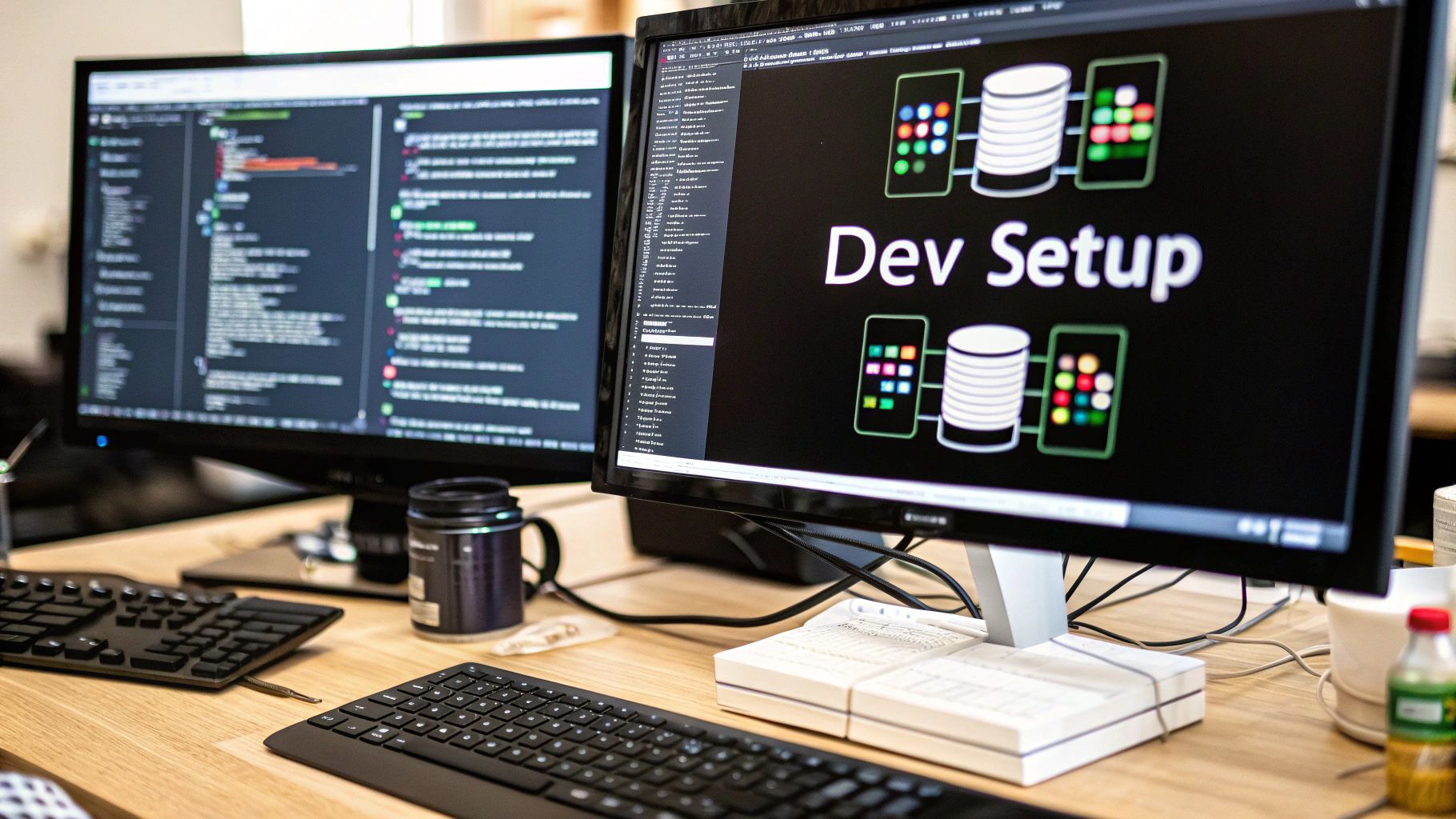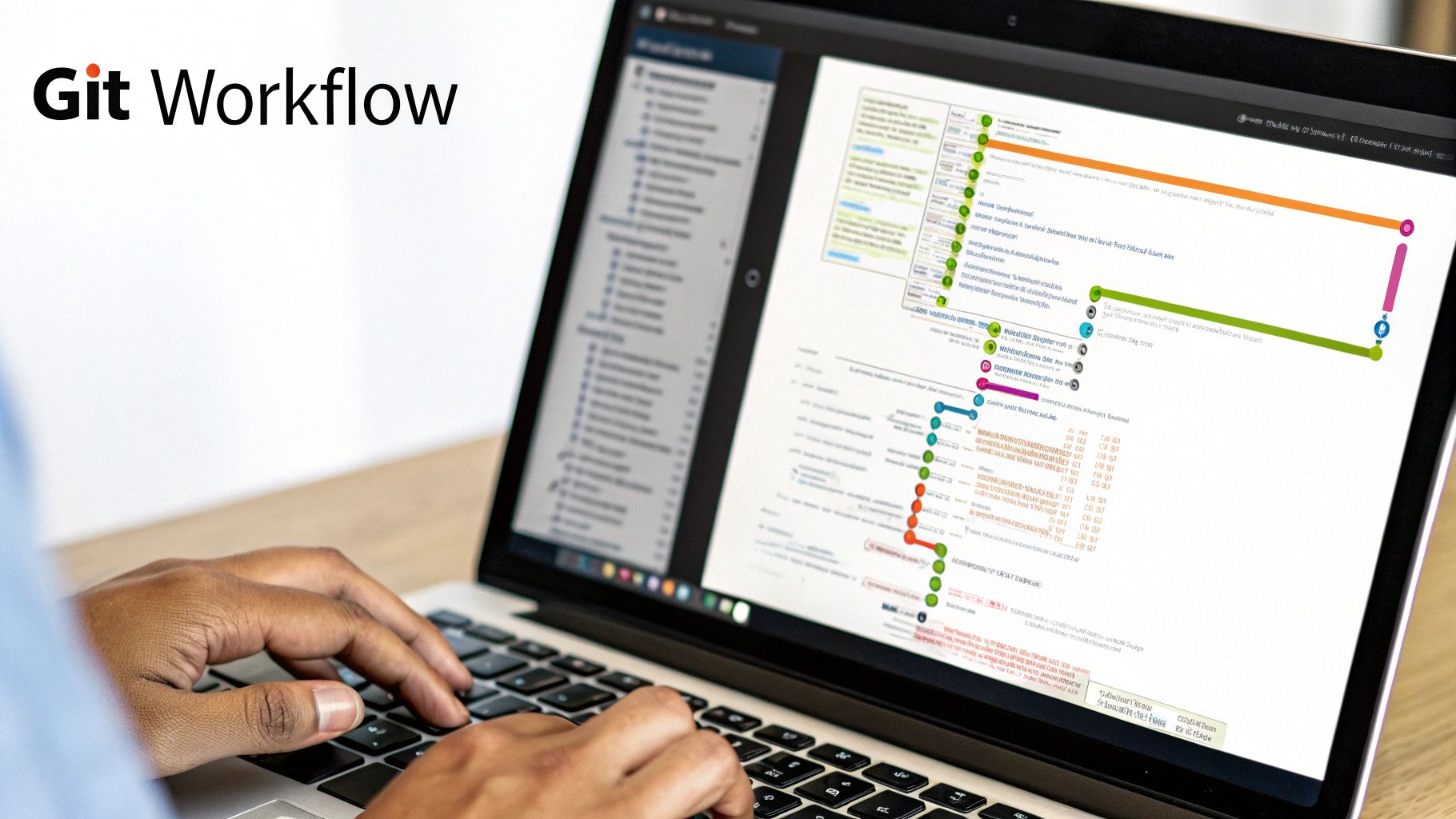Developer Onboarding Checklist: 8 Key Steps for Success
Setting the Stage for Developer Success
A well-structured developer onboarding checklist is crucial for quickly integrating new hires into your team and projects. This checklist provides a comprehensive roadmap covering essential steps, tools, and best practices, ensuring a smooth and efficient onboarding experience. This detailed guide goes beyond the basics, offering actionable insights and practical implementation details to set your new developers up for immediate success. Successfully onboarding developers boosts team productivity, reduces initial friction, and contributes directly to overall project success. We’ll cover key areas, from pre-boarding preparation and development environment setup to fostering team integration and providing ongoing mentorship.
To ensure a smooth transition for new hires, consider implementing a robust checklist. You can find a detailed example of a remote employee onboarding checklist for success from Remote First Jobs. This resource complements the developer-specific steps we'll cover, offering a broader perspective on onboarding best practices.
This developer onboarding checklist covers the following key aspects:
- Pre-boarding: System Access & Account Setup
- Development Environment Configuration
- Code Repository Access & Version Control Training
- Team Introductions & Communication Channels
- Architecture & Codebase Overview
- Development Workflow & Processes
- First Assignment & Mentorship
- Security & Compliance Training
By following these steps, you can create a consistent and effective onboarding process, minimizing the ramp-up time for new developers and maximizing their contributions to your team. This comprehensive approach ensures new hires feel welcome, prepared, and empowered to contribute quickly, laying the groundwork for long-term success within your organization.
1. Pre-boarding: System Access & Account Setup
A smooth developer onboarding experience begins long before the developer's first day. It starts with pre-boarding: the crucial process of preparing all necessary system access, accounts, and credentials. This proactive approach prevents day-one roadblocks and sets the stage for a productive start. Pre-boarding encompasses creating user accounts, provisioning hardware (if applicable), setting up development environments, and ensuring all security clearances are finalized. This foundational step minimizes initial frustration and allows new hires to contribute quickly.

Why Pre-boarding Matters
Pre-boarding demonstrates an organization's commitment to its new hires. It fosters a positive first impression and reduces the anxiety often associated with starting a new role. For the team, pre-boarding saves valuable time and resources. It allows senior developers to focus on mentoring and collaboration rather than troubleshooting access issues. If you're exploring the current engineering landscape, take a look at available Engineering Jobs to understand the demands and opportunities. This resource from Find Web3 - Jobs - Engineering can provide valuable insights into the market.
Examples of Successful Pre-boarding
Several leading tech companies have mastered the art of pre-boarding. Spotify, for example, utilizes automated developer environment provisioning, ensuring consistency and speed. Netflix leverages cloud-based development workspaces, allowing developers to access their environment from anywhere. Atlassian’s integrated identity management system streamlines access control across various platforms. GitHub automates repository access provisioning, granting developers the necessary permissions upon joining.
Actionable Tips for Effective Pre-boarding
- Infrastructure as Code (IaC): Utilize IaC tools like Terraform for repeatable and consistent environment setups. This eliminates manual configuration and minimizes errors.
- Automated Testing: Implement automated tests for your provisioning scripts to catch potential issues before they affect new hires.
- Rollback Procedures: Establish clear rollback procedures for failed setups to quickly revert to a working state.
- Audit Trails: Maintain detailed audit trails of all access grants for security and compliance purposes.
- Temporary Credentials: Use temporary credentials that require activation by the new hire to enhance security.
When and Why to Use Pre-boarding
Pre-boarding should be a standard practice for any organization onboarding developers. It is particularly critical when:
- Scaling rapidly: Automating pre-boarding processes becomes essential when handling a large influx of new hires.
- Remote teams: Pre-boarding ensures remote developers have access to the necessary resources from day one, regardless of location.
- Complex development environments: Streamlined access and setup are vital when dealing with intricate systems and configurations.
This initial setup stage forms the bedrock of a successful developer onboarding checklist. By prioritizing pre-boarding, organizations can significantly improve the new hire experience, boost productivity, and create a positive, welcoming environment.
2. Development Environment Configuration
A consistent and reproducible development environment is paramount for developer productivity and smooth onboarding. It minimizes the "works on my machine" problem and ensures all developers are working with the same tools and dependencies. This involves configuring IDEs, installing necessary tools, setting up local databases, and managing dependencies through containerization or virtual environments. A well-configured environment allows new developers to quickly integrate into the team and contribute effectively.

Why Development Environment Configuration Matters
A standardized development environment promotes collaboration, reduces integration issues, and accelerates the development lifecycle. It ensures consistency across different developer machines, simplifying debugging and testing. This consistency also contributes to a smoother onboarding process, allowing new hires to focus on learning the codebase rather than wrestling with environment setup.
Examples of Successful Development Environment Configuration
Several companies demonstrate best practices in development environment configuration. GitHub Codespaces provides cloud-based environments, enabling developers to contribute from anywhere. Shopify leverages containerized development environments, ensuring consistency across teams. Slack utilizes a standardized Docker development environment, simplifying onboarding and reducing friction. Airbnb has implemented a unified development toolchain, improving developer experience and streamlining workflows.
Actionable Tips for Effective Development Environment Configuration
- Docker-Compose: Use docker-compose for managing multi-service applications. This simplifies the orchestration of complex development environments.
- Documentation: Document the environment setup process in README files. This provides a clear guide for new developers and ensures consistency.
- Automated Setup: Provide automated setup scripts to simplify the process. Offer manual instructions as a backup for flexibility.
- Health Checks: Include health checks for all services in the development environment. This allows developers to quickly identify and resolve issues.
- Version Control: Version control your development environment configuration (e.g., using Git). This enables tracking changes and facilitates rollback if needed.
When and Why to Use Standardized Development Environments
Standardized development environments are beneficial for any development team. They are especially crucial when:
- Onboarding new developers: A pre-configured environment reduces setup time and allows new hires to contribute quickly.
- Working with remote teams: Consistent environments ensure everyone is working with the same tools and dependencies, regardless of location.
- Complex projects: Containerization or virtual environments isolate dependencies, preventing conflicts and simplifying management.
- Microservice architectures: Docker-compose facilitates the orchestration and management of multiple interconnected services.
This emphasis on a consistent development environment is a key part of a comprehensive developer onboarding checklist. By implementing these strategies, teams can streamline workflows, reduce errors, and create a more efficient and collaborative development process. This allows developers to focus on building great software, knowing their environment is consistent and reliable. A well-configured development environment empowers developers and sets the stage for a successful onboarding experience.
3. Code Repository Access & Version Control Training
Effective developer onboarding hinges on providing immediate access to code repositories and robust training on version control. This equips new hires with the tools and knowledge to contribute to projects quickly. Understanding core concepts like Git workflows, branching strategies, repository structure, and team collaboration practices is essential for a smooth integration into the development team. Setting up the right development environment is crucial for a developer's productivity; read more about configuring a Laravel Nodejs Development Environment. This resource from Set Up Laravel Nodejs Development Environment On Windows With Wsl 2 Ubuntu 24 from Sohaib Ilyas offers valuable setup insights.

Why Version Control Training Matters
Version control training minimizes the risk of code conflicts and integration issues. It promotes consistent code quality and fosters a collaborative development environment. Proficient version control skills empower developers to work efficiently and confidently, contributing to faster release cycles and higher-quality software.
Examples of Successful Version Control Practices
Many organizations have adopted robust version control workflows. Google's Mondrian code review system emphasizes thorough peer reviews. Microsoft leverages pull request workflows in Azure DevOps for collaborative development. Facebook’s differential code review process facilitates detailed code analysis. The Apache Software Foundation showcases the power of open-source collaboration through distributed version control.
Actionable Tips for Effective Version Control Training
- Start Simple: Introduce basic workflows before delving into complex branching strategies.
- Provide Resources: Offer Git cheat sheets and readily accessible references for common commands.
- Visualize Branching: Employ visual tools to illustrate branching strategies and merge processes.
- Automate Checks: Implement automated checks for commit message formats to ensure consistency.
- Use Templates: Create standardized templates for pull request descriptions to streamline the review process.
When and Why to Implement Version Control Training
Version control training should be an integral part of any developer onboarding program. It's particularly crucial when:
- Adopting new technologies: Training ensures consistent usage of version control across different platforms.
- Scaling development teams: Standardized practices become essential with larger teams and more complex projects.
- Improving code quality: Robust version control processes contribute directly to better code quality and fewer bugs.
Integrating developers effectively into the codebase and development workflow is critical for project success. By prioritizing code repository access and providing comprehensive version control training, organizations empower their new hires to contribute meaningfully from day one. This step in the developer onboarding checklist ensures a smooth transition and sets the stage for long-term productivity and code quality.
4. Team Introductions & Communication Channels
Effective developer onboarding extends beyond technical setup. It involves integrating new hires into the team, fostering connections, and establishing clear communication pathways. This ensures a smooth transition, reduces initial uncertainty, and sets the stage for collaborative success. Team introductions and communication channel setup are crucial for creating a welcoming and productive environment. This involves introducing new developers to their immediate team, key stakeholders, and relevant collaborators. It also includes setting up necessary communication channels and explaining team dynamics and communication protocols.

Why Team Introductions & Communication Matter
Early integration into the team dynamic boosts morale and accelerates a new developer's understanding of the project and company culture. Clear communication channels prevent misunderstandings and promote efficient collaboration. A strong understanding of team dynamics, communication styles, and preferred tools ensures everyone stays aligned. Learn more about Team Introductions & Communication Channels and their impact on the onboarding process.
Examples of Successful Team Integration
Several organizations excel at team introductions. Buffer champions a transparent team introduction process, sharing individual profiles and team dynamics. Zapier's remote-first onboarding emphasizes early connections through virtual coffee chats and team-building activities. Spotify’s squad-based team integration facilitates faster onboarding within smaller, focused groups. GitLab, known for its asynchronous communication, leverages detailed documentation and introductory videos for seamless team introductions.
Actionable Tips for Effective Team Integration
- Schedule introductory meetings: Arrange meetings between the new developer and their team, key stakeholders, and collaborators.
- Create team member profiles: Provide photos, backgrounds, and areas of expertise to personalize introductions.
- Icebreaker activities: Use icebreakers in team meetings to foster connections and build rapport.
- Buddy system: Assign a buddy or mentor for ongoing support and guidance.
- Document communication preferences: Clearly outline team communication preferences, hours, and preferred tools.
When and Why to Prioritize Team Integration
Team introductions and communication channel setup should be a priority from day one. This is particularly crucial when:
- Building new teams: Establishing clear communication and team dynamics is essential when forming new teams.
- Integrating remote developers: Early connections are vital for remote developers to feel included and connected to the team.
- Large, distributed teams: Formal introduction processes and clear communication channels prevent isolation and confusion.
Integrating new developers effectively into the team structure and establishing clear communication protocols is a cornerstone of a successful developer onboarding checklist. This fosters a welcoming environment, promotes collaboration, and sets the stage for long-term success.
5. Architecture & Codebase Overview
A crucial aspect of successful developer onboarding is providing a comprehensive understanding of the system architecture and codebase. This involves clear documentation and walkthroughs explaining the structure, design patterns, and underlying technical decisions. New developers need to grasp the relationships between services, data flow, and architectural principles guiding development. This empowers them to contribute effectively and make informed decisions from the outset.
Why an Architecture Overview Matters
Understanding the system architecture is fundamental for developers to navigate the codebase, troubleshoot issues, and propose meaningful changes. A well-structured overview accelerates the learning curve, reduces the likelihood of introducing bugs, and promotes efficient collaboration within the team. It fosters a sense of ownership and empowers developers to contribute confidently.
Examples of Successful Implementations
Several leading tech companies excel at providing architectural documentation. Uber's microservices architecture documentation, for example, offers a clear overview of their distributed system. Netflix's cloud architecture guides detail their robust and scalable infrastructure. Airbnb’s service mesh documentation clarifies inter-service communication. Spotify's backend service architecture overview explains the organization of their complex music streaming platform. These resources serve as excellent examples of clear and comprehensive architectural documentation.
Actionable Tips for Effective Documentation
- Visual Diagrams and Flowcharts: Use visual aids to illustrate system components, relationships, and data flow. This makes complex architectures easier to understand.
- High-Level and Detailed Views: Provide both a bird's-eye view of the system and detailed explanations of individual components. This caters to different learning styles and needs.
- Architectural Decision Records (ADRs): Document the rationale behind architectural choices to provide context and promote consistency. This fosters understanding and avoids reinventing the wheel.
- Interactive Code Tours or Walkthroughs: Create guided tours of the codebase to highlight key areas and functionality. This allows developers to explore the code in a structured manner.
- Regular Updates: Integrate documentation updates into the development process to ensure it remains accurate and relevant.
When and Why to Use an Architectural Overview
Providing an architectural overview is essential during developer onboarding, especially when:
- Complex Systems: Understanding the architecture is crucial for navigating intricate systems with multiple components and dependencies.
- Microservices Architectures: Clear documentation is vital for understanding the interactions between various microservices.
- Distributed Systems: An overview helps developers grasp the distributed nature of the system and its implications for development.
- Large Codebases: Navigating a large codebase becomes significantly easier with a clear understanding of its structure and organization.
This detailed understanding of the system architecture and codebase is a cornerstone of effective developer onboarding. By providing clear documentation and walkthroughs, organizations empower new hires to become productive contributors quickly and efficiently. This sets the stage for long-term success and fosters a culture of shared understanding within the development team. Including this as part of your developer onboarding checklist ensures new hires gain a solid foundation in the system's architecture, enabling them to contribute effectively and confidently.
6. Development Workflow & Processes
A well-defined development workflow is crucial for a productive team. This encompasses the entire development lifecycle, from task management and sprint planning to code deployment, testing procedures, and release processes. Effective onboarding must include comprehensive training on these processes, covering the specific tools, methodologies, and quality assurance practices used within the organization. This equips new developers to integrate seamlessly and contribute efficiently from the start. A clear understanding of workflows minimizes confusion and fosters a collaborative environment.
Why Development Workflow Training Matters
Understanding the development workflow is essential for new developers to contribute effectively. It ensures they understand how their work fits into the larger picture, promoting a sense of ownership and purpose. Consistent processes also improve code quality, reduce errors, and accelerate delivery cycles. For example, a well-defined CI/CD pipeline can automate many aspects of the development process, freeing up developers to focus on coding and innovation. Learn more about these best practices in our post on CI/CD pipeline best practices.
Examples of Successful Workflow Implementation
Many successful tech companies have refined their development workflows. Spotify's agile scaling model, using Squads, Tribes, and Chapters, promotes autonomy and alignment within large engineering teams. Google’s testing pyramid implementation emphasizes the importance of different testing layers for robust software. Facebook's continuous deployment pipeline allows for rapid and frequent releases, while Amazon's two-pizza team methodology fosters focused and agile development.
Actionable Tips for Effective Workflow Training
- Start with core processes: Begin by training new hires on the most critical workflows before introducing more complex procedures.
- Provide process flowcharts and quick reference guides: Visual aids simplify complex processes and provide easy access to essential information.
- Include rationale for each process step: Explaining the "why" behind each step enhances understanding and encourages adherence.
- Make processes visible and easy to follow: Document all workflows clearly and make them readily accessible to the entire team.
- Regularly review and optimize workflows: Processes should be dynamic and adapt to the evolving needs of the team and project.
When and Why to Implement Workflow Training
Development workflow training is essential during the onboarding process for all new developers. It’s particularly crucial when:
- Introducing new tools or technologies: Training ensures developers can effectively utilize new resources within the established workflow.
- Scaling the team: Standardized processes become even more critical with larger teams to maintain consistency and quality.
- Adopting new methodologies (e.g., Agile, DevOps): Thorough training is needed to ensure a successful transition to new development practices.
A comprehensive understanding of the development workflow is a cornerstone of effective developer onboarding. By prioritizing this training, organizations empower their new hires to become productive contributors quickly, fostering a culture of collaboration, efficiency, and continuous improvement. This ultimately leads to better software and faster delivery cycles, benefiting both the team and the business.
7. First Assignment & Mentorship
A well-structured developer onboarding checklist must include a thoughtfully chosen first assignment and a robust mentorship program. This crucial step bridges the gap between theoretical knowledge and practical application within the company's specific environment. A suitable first task allows new developers to make tangible contributions while simultaneously familiarizing themselves with the codebase, development processes, and team dynamics. Pairing this with experienced mentors provides guidance, fosters a sense of belonging, and accelerates the learning curve.
Why First Assignment & Mentorship Matters
The first assignment serves as a practical introduction to the company’s development workflow. It offers a controlled environment for new hires to apply their skills, learn the codebase, and understand the team’s collaborative approach. Mentorship, in parallel, provides personalized support and guidance, addressing individual learning styles and challenges. This combination creates a powerful learning experience that boosts confidence and accelerates integration into the team. A successful first assignment and mentorship program contributes significantly to developer retention and long-term success.
Examples of Successful First Assignment & Mentorship
Several companies excel at integrating new developers through strategic first assignments and mentorship. Google's 'Noogler' program pairs new hires with dedicated mentors for comprehensive guidance. Etsy's 'Deploy on Day One' philosophy encourages immediate contribution, giving new developers a sense of ownership. Shopify promotes pair programming, enabling real-time learning and collaboration. GitHub's 'good first issue' labeling system provides clear entry points for new contributors, fostering a sense of accomplishment.
Actionable Tips for Effective First Assignment & Mentorship
- Choose impactful tasks: Select tasks that touch multiple parts of the system, offering a broader understanding of the codebase architecture.
- Define clear criteria: Ensure tasks have explicit acceptance criteria to guide the developer and measure success.
- Holistic mentorship: Provide mentorship that addresses both technical skills and cultural integration within the team.
- Regular meetings: Schedule regular mentor-mentee meetings for consistent feedback and support.
- Document solutions: Document common first-task patterns and solutions to create a valuable knowledge base for future onboarding.
When and Why to Use First Assignment & Mentorship
First assignment and mentorship should be integral to every developer onboarding process. This approach is particularly crucial when:
- Onboarding junior developers: Structured guidance and support are essential for developers with less experience.
- Introducing new technologies: Mentorship helps developers quickly grasp new tools and frameworks used within the organization.
- Complex codebases: A guided approach simplifies navigating large and intricate codebases, preventing overwhelm.
- Distributed teams: Regular communication and mentorship bridge the gap in remote work environments, fostering connection and collaboration.
This combination of hands-on experience and personalized guidance sets the stage for long-term developer success. By incorporating a well-structured first assignment and a dedicated mentorship program, organizations can significantly enhance the developer onboarding experience, foster a positive learning environment, and accelerate the integration of new talent into their teams. This is a key component of a comprehensive developer onboarding checklist.
8. Security & Compliance Training
A critical component of any developer onboarding checklist is comprehensive security and compliance training. This equips new developers with the knowledge and skills to navigate the organization's security landscape, adhere to industry regulations, and protect sensitive data. Security training encompasses secure coding practices, data protection protocols, understanding security policies, and incident response procedures. Compliance training focuses on adhering to specific industry standards and legal requirements relevant to the organization's operations.
Why Security & Compliance Training Matters
Security breaches can have devastating consequences, from financial losses to reputational damage. By investing in robust security and compliance training, organizations mitigate these risks and foster a security-conscious culture. This training empowers developers to identify potential vulnerabilities, prevent security incidents, and respond effectively to threats. For developers, this knowledge is essential for career advancement and demonstrates a commitment to responsible development practices. Learn more about GitHub compliance as a practical example of security integration.
Examples of Successful Security & Compliance Training
Many organizations leverage established frameworks and resources for their security training programs. Microsoft's Security Development Lifecycle (SDL) provides a comprehensive approach to building secure software. Google's secure coding practices offer detailed guidance on preventing common vulnerabilities. OWASP's secure development guidelines provide a valuable resource for web application security. Financial services companies often implement rigorous compliance training programs to meet industry-specific regulations.
Actionable Tips for Effective Security & Compliance Training
- Integrate security tools into the development workflow: Introduce developers to security tools like static analysis scanners and vulnerability assessment platforms early in the onboarding process.
- Provide security checklists and automated checks: These tools can help enforce secure coding practices and identify potential issues before they reach production.
- Use real-world examples and case studies: Engaging training materials with practical examples and case studies can enhance understanding and retention.
- Make security training engaging and practical: Interactive exercises, simulations, and gamified learning can improve the overall learning experience.
- Regularly update training content for new threats: The security landscape is constantly evolving, so ensure training materials are up-to-date with the latest threats and vulnerabilities.
When and Why to Use Security & Compliance Training
Security and compliance training should be mandatory for all developers, regardless of their experience level or role. It is particularly crucial when:
- Handling sensitive data: Industries like healthcare and finance require stringent security measures to protect confidential information.
- Developing web applications: Web applications are often targeted by attackers, making secure coding practices essential.
- Working in regulated industries: Compliance with industry regulations is mandatory and requires specific training programs.
- Operating in a cloud environment: Cloud security presents unique challenges that require specialized training.
By prioritizing security and compliance training during developer onboarding, organizations cultivate a security-first mindset, reduce the risk of breaches, and ensure adherence to industry standards. This proactive approach safeguards both the organization and its developers.
Developer Onboarding Checklist Comparison
| Onboarding Item | Implementation Complexity 🔄 | Resource Requirements ⚡ | Expected Outcomes 📊 | Ideal Use Cases 💡 | Key Advantages ⭐ | |--------------------------------------|-------------------------------------------------|-------------------------------------------|--------------------------------------------------|-------------------------------------------------|-------------------------------------------------| | Pre-boarding: System Access & Account Setup | High – involves automation and integrations | Medium–High – automation tools, IT support | Immediate productivity, security compliance | New hire day zero readiness, secure system access | Eliminates delays, ensures security, reduces IT support | | Development Environment Configuration | Medium – containerization and tool setup | Medium – container tools, environment configs | Consistent dev experience, reduces machine conflicts | Teams needing reproducible dev environments | Standardizes setups, eases debugging, speeds commits | | Code Repository Access & Version Control Training | Medium – requires training and policy enforcement | Low–Medium – training materials, tool access | Improved collaboration, better code quality | Teams using Git with defined workflows | Reduces merge conflicts, enforces reviews, standardizes collaboration | | Team Introductions & Communication Channels | Low – scheduling and platform setup | Low – communication tools, time investment | Stronger team rapport, better communication | Remote or new teams with distributed members | Enhances collaboration, reduces isolation, builds rapport | | Architecture & Codebase Overview | Medium – documentation and walkthrough creation | Medium – time investment for docs and updates | Faster understanding of complex systems | Complex codebases requiring onboarding clarity | Enables informed decisions, prevents mistakes, maintains consistency | | Development Workflow & Processes | Medium-High – process training and adoption | Medium – project management & QA tools | Consistent dev practices, improved planning | Agile teams, structured development lifecycles | Improves quality, coordination, and reduces risks | | First Assignment & Mentorship | Medium – task selection and mentor availability | Medium – mentor time and oversight | Early contributions, confidence building | New hires needing hands-on learning | Builds skills, creates mentorship, enables value contribution | | Security & Compliance Training | Medium – ongoing training and policy updates | Medium – training content, security tools | Secure coding culture, regulatory compliance | Regulated environments or sensitive applications | Prevents vulnerabilities, ensures compliance, raises security awareness |
Reap the Rewards of Effective Onboarding
This developer onboarding checklist provides a comprehensive guide to integrating new developers seamlessly into your team. From pre-boarding preparations to their first assignment, each step plays a crucial role in setting them up for success. A well-structured onboarding process isn't just about ticking boxes; it's about fostering a positive and productive environment where developers can thrive.
The Impact of a Strong Onboarding Experience
A strong onboarding experience has a ripple effect throughout your organization. It directly impacts key areas like developer satisfaction, project timelines, and code quality. When developers feel supported and well-equipped from day one, they are more likely to be engaged, productive, and committed to the team's success. This translates to faster ramp-up times, reduced errors, and a more positive overall work environment.
Key Takeaways and Actionable Next Steps
Let's recap the essential elements of a successful developer onboarding checklist:
-
Pre-boarding: Ensure all necessary accounts and system access are ready before the developer's start date. This eliminates initial roadblocks and demonstrates organizational preparedness.
-
Environment Setup: Provide clear documentation and support for configuring the development environment. This reduces frustration and empowers developers to contribute quickly.
-
Codebase Immersion: Introduce the architecture, coding standards, and version control system early. This fosters code quality and promotes best practices from the beginning.
-
Team Integration: Facilitate introductions and communication channel onboarding. This creates a sense of belonging and opens pathways for collaboration.
-
Mentorship and Guidance: Pair new developers with experienced mentors who can provide support and guidance. This accelerates learning and fosters a culture of knowledge sharing.
By implementing these key takeaways, you can significantly improve the onboarding process for new developers. Start by reviewing your current process and identify areas for improvement. Prioritize the elements that have the biggest impact on developer productivity and satisfaction.
From Onboarding to Long-Term Success
Effective onboarding is an investment in your team's future. It's not merely a process but a strategic initiative that lays the foundation for long-term success. By providing a structured and supportive environment, you empower developers to reach their full potential, contributing valuable insights and innovation to your projects.
Mastering the Developer Onboarding Checklist
Mastering the elements outlined in this developer onboarding checklist allows you to create a repeatable and scalable process. This ensures consistency in onboarding, regardless of team size or project complexity. A standardized approach also frees up valuable time for engineering managers and mentors, allowing them to focus on higher-level tasks.
A consistent and well-executed developer onboarding process is a cornerstone of high-performing engineering teams. It's the first step in fostering a culture of growth, collaboration, and continuous improvement. Embrace the developer onboarding checklist as a living document, adapting and refining it as your team evolves and your needs change.
Streamline your developer onboarding process and boost team productivity with Pull Checklist. Pull Checklist provides customizable templates and automated workflows designed to create a seamless and efficient onboarding experience. Visit Pull Checklist today to learn more.
